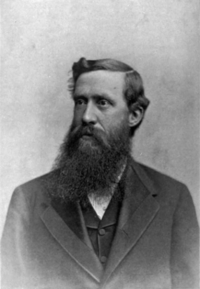Elliott Coues facts for kids
Quick facts for kids
Elliott Coues
|
|
|---|---|
 |
|
| Born |
Elliott Ladd Coues
September 9, 1842 |
| Died | December 25, 1899 (aged 57) Baltimore, Maryland, U.S.
|
| Alma mater | Columbian University |
| Scientific career | |
| Fields | Ornithology |
Elliott Ladd Coues (born September 9, 1842 – died December 25, 1899) was an American army doctor, historian, and expert on birds (an ornithologist). He also wrote many books. He explored areas like the Arizona Territory. Later, he became secretary of the United States Geological and Geographical Survey of the Territories. He helped start the American Ornithological Union in 1883. He was also the editor of its important magazine, The Auk.
Biography
Elliott Coues was born in Portsmouth, New Hampshire. His parents were Samuel Elliott Coues and Charlotte Haven Ladd Coues. He went to Columbian University in Washington, D.C.. He graduated in 1861 and finished medical school there in 1863.
In 1864, he became an assistant-surgeon in the army. He was sent to Fort Whipple, Arizona. In 1872, he published his book Key to North American Birds. This book was updated in 1884 and 1901. It greatly helped people learn about birds in North America.
Contributions to Ornithology
In 1883, Coues helped create the American Ornithologists' Union. He was one of its founding members. He also edited The Auk, which was the union's main publication. His work was very important for how scientists name different types of animals. He helped set the rules for using trinomial nomenclature. This is a way to classify subspecies (smaller groups within a species). These rules are now used in all of zoology.
From 1873 to 1876, Coues worked as a surgeon and naturalist for the U.S. Northern Boundary Commission. From 1876 to 1880, he was a secretary and naturalist for the United States Geological and Geographical Survey of the Territories. He also edited their publications. He taught anatomy at the Columbian University medical school from 1877 to 1887.
Coues was very careful when listing scientific writings. In his book Birds of the Colorado Valley, he wrote about swallows. At the time, some people believed swallows hibernated under lakes in winter. Coues discussed this idea, even though he had never seen it himself. He said that if the evidence was strong, scientists should consider it. He compared it to how some reptiles, amphibians, and bats hibernate.
In 1878, he became a member of the American Philosophical Society. He left the army in 1881 to focus completely on science. He passed away in Baltimore, Maryland in 1899.
Animals Named After Coues
Elliott Coues discovered a bird species called Grace's warbler in the Rocky Mountains in 1864. He asked for it to be named after his 18-year-old sister, Grace Darling Coues. This request was honored in 1865.
He also did important work studying mammals. His book Fur-Bearing Animals (1877) was known for its accurate descriptions of species. Some of these animals were already becoming rare. The Coues' white-tailed deer (Odocoileus virginianus couesi) is named after him. Also, a type of Cactus wren (Campylorhynchus brunneicapillus couesi) is named after him. This specific bird is the state bird of Arizona. This honors Coues' important work in surveying early Arizona.
Spirituality
Coues was interested in spiritualism and Theosophy. He was friends with Alfred Russel Wallace. They even attended séances, which are meetings where people try to talk to spirits.
Coues felt that traditional science could not explain all the deeper questions about human life. He believed in evolution. He thought its ideas could be used to understand things like hypnotism, clairvoyance (seeing things beyond normal sight), and telepathy (mind-to-mind communication). He claimed to have seen objects levitate (float in the air). He wrote an article about his theory of levitation in The Metaphysical Magazine in 1895.
Coues joined the Theosophical Society in 1884. He visited Helena Blavatsky, a leader of the society, in Europe. He later became president of the Theosophical Society in 1890. However, he eventually became critical of Blavatsky and lost interest in the Theosophical movement. He was later removed from the society in 1899. Coues continued to be interested in Eastern religious ideas and later studied Islam.
See also
 In Spanish: Elliott Coues para niños
In Spanish: Elliott Coues para niños

